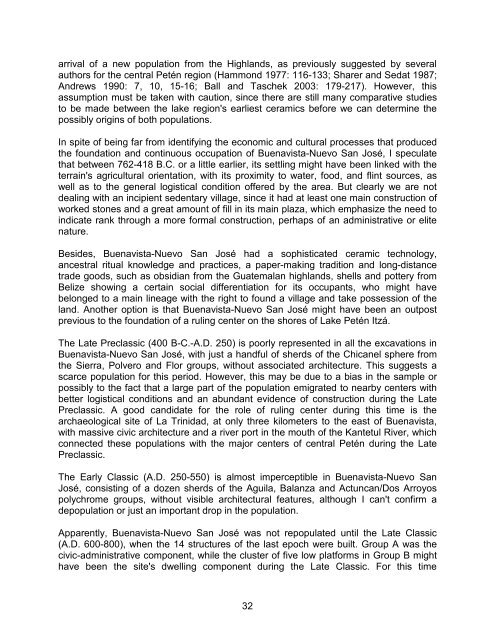Buenavista-Nuevo San José, Petén, Guatemala: Another ... - Famsi
Buenavista-Nuevo San José, Petén, Guatemala: Another ... - Famsi
Buenavista-Nuevo San José, Petén, Guatemala: Another ... - Famsi
You also want an ePaper? Increase the reach of your titles
YUMPU automatically turns print PDFs into web optimized ePapers that Google loves.
arrival of a new population from the Highlands, as previously suggested by several<br />
authors for the central <strong>Petén</strong> region (Hammond 1977: 116-133; Sharer and Sedat 1987;<br />
Andrews 1990: 7, 10, 15-16; Ball and Taschek 2003: 179-217). However, this<br />
assumption must be taken with caution, since there are still many comparative studies<br />
to be made between the lake region's earliest ceramics before we can determine the<br />
possibly origins of both populations.<br />
In spite of being far from identifying the economic and cultural processes that produced<br />
the foundation and continuous occupation of <strong>Buenavista</strong>-<strong>Nuevo</strong> <strong>San</strong> <strong>José</strong>, I speculate<br />
that between 762-418 B.C. or a little earlier, its settling might have been linked with the<br />
terrain's agricultural orientation, with its proximity to water, food, and flint sources, as<br />
well as to the general logistical condition offered by the area. But clearly we are not<br />
dealing with an incipient sedentary village, since it had at least one main construction of<br />
worked stones and a great amount of fill in its main plaza, which emphasize the need to<br />
indicate rank through a more formal construction, perhaps of an administrative or elite<br />
nature.<br />
Besides, <strong>Buenavista</strong>-<strong>Nuevo</strong> <strong>San</strong> <strong>José</strong> had a sophisticated ceramic technology,<br />
ancestral ritual knowledge and practices, a paper-making tradition and long-distance<br />
trade goods, such as obsidian from the <strong>Guatemala</strong>n highlands, shells and pottery from<br />
Belize showing a certain social differentiation for its occupants, who might have<br />
belonged to a main lineage with the right to found a village and take possession of the<br />
land. <strong>Another</strong> option is that <strong>Buenavista</strong>-<strong>Nuevo</strong> <strong>San</strong> <strong>José</strong> might have been an outpost<br />
previous to the foundation of a ruling center on the shores of Lake <strong>Petén</strong> Itzá.<br />
The Late Preclassic (400 B-C.-A.D. 250) is poorly represented in all the excavations in<br />
<strong>Buenavista</strong>-<strong>Nuevo</strong> <strong>San</strong> <strong>José</strong>, with just a handful of sherds of the Chicanel sphere from<br />
the Sierra, Polvero and Flor groups, without associated architecture. This suggests a<br />
scarce population for this period. However, this may be due to a bias in the sample or<br />
possibly to the fact that a large part of the population emigrated to nearby centers with<br />
better logistical conditions and an abundant evidence of construction during the Late<br />
Preclassic. A good candidate for the role of ruling center during this time is the<br />
archaeological site of La Trinidad, at only three kilometers to the east of <strong>Buenavista</strong>,<br />
with massive civic architecture and a river port in the mouth of the Kantetul River, which<br />
connected these populations with the major centers of central <strong>Petén</strong> during the Late<br />
Preclassic.<br />
The Early Classic (A.D. 250-550) is almost imperceptible in <strong>Buenavista</strong>-<strong>Nuevo</strong> <strong>San</strong><br />
<strong>José</strong>, consisting of a dozen sherds of the Aguila, Balanza and Actuncan/Dos Arroyos<br />
polychrome groups, without visible architectural features, although I can't confirm a<br />
depopulation or just an important drop in the population.<br />
Apparently, <strong>Buenavista</strong>-<strong>Nuevo</strong> <strong>San</strong> <strong>José</strong> was not repopulated until the Late Classic<br />
(A.D. 600-800), when the 14 structures of the last epoch were built. Group A was the<br />
civic-administrative component, while the cluster of five low platforms in Group B might<br />
have been the site's dwelling component during the Late Classic. For this time<br />
32
















